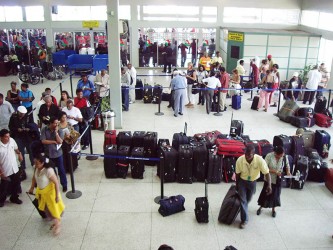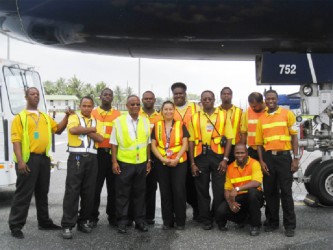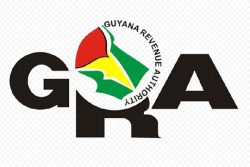Across the world, airlines outsource more than 50% of their ground handling operations and the trend is growing.
At first glance the term ground handling conjures up unending manual labour associated with the mundaneness of, first, receiving flights then putting in place the basic requisites for their turnaround. Nothing could be further from the truth, says Roraima Airways’ Head of Ground Handling Operations Sasha Persaud.
While international airlines serving Guyana contract out their ground handling to local service providers, Persaud says airlines’ due diligence on the contractors is usually particularly rigorous. The service contracts, she says, are signed against the backdrop of a clear understanding that the service provider’s employees must undergo a rigorous regime of training by the airline. Persaud says while there are universally International Air Transport Association (IATA) approved ground handling procedures, every airline has its own personal idiosyncrasies and seeks to ensure that its preferences and procedures are recognised and adhered to.
A 14-year veteran of the sector, Persaud says her job is as much a passion as it is a vocation. It allows her to put into practice what she says is her passion for “paying attention to detail.”

The practice by international airlines of outsourcing ground handling has created an industry worth billions of dollars. For developing countries like Guyana, ground handling also provides considerable numbers of jobs. Persaud told Stabroek Business that during the period when Roraima Airways served Delta Airlines the company had a ground handling staff of more than 60 persons. That number has shrunk though, with the recent service agreement signed with Insel Air those numbers are set to rise again,
While much of the focus in the aviation sector targets aircraft in flight, Persaud says the reinforcement for safety and comfort is laid on the ground. Ground handling, she says, lays the foundation for that safety and comfort. She explains that ground handling is divided between “above wing” and below wing” services. The above wing services target issues to do with the well-being of passengers, beginning with the provision of mobile stairs to facilitate disembarkation. Below wing services include the provision of baggage conveyor belts and equipment for moving aircraft.
While moving baggage and hauling enormous aircraft around make ground handling a weighty job, Persaud says the more onerous responsibility reposes in protecting the image of the airline.
As the aviation industry confronts greater challenges the responsibilities of ground handling become more complex. Bonita Gonsalves, a senior member of the Roraima ground handling outfit and Head of the below wing team told Stabroek Business that the June 1984 Lockerbie air disaster ushered in a new global regime of airline safety protocols and brought some fundamental changes to ground handling.

Asked whether there is a security responsibility in the work of the ground handler, Persaud points out that while the sector has its aviation specialists, security cuts across all of the various services in the sector. She says the training of ground handling personnel speaks to security issues. “We know what to look for,” she says.
On the whole, the training is as sustained as it is rigorous. As Head of Ground Handling, Persaud must put her job on the line once a year, undergoing an annual qualification. If she fails that test she can no longer perform ground handling services for the examining airline. Other routine examinations have to do with – among other things – dangerous drugs, ramp handling, passenger disability and ground security. There are more than 26 examinations annually.
For all of its challenges, ground handling has its rewards. Persaud says once you come to understand the essence of the job you grow to recognise the importance of your assignment. “The simple truth,” she says, “is that ground handling can make or break an airline.”








